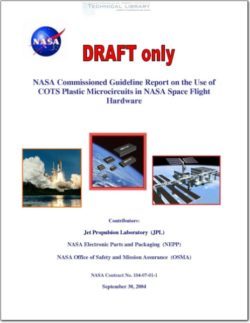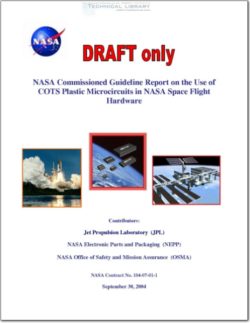NASA-CON-104-07-01-1

- Version
- 179 Downloads
- 673.70 KB File Size
- 1 File Count
- May 19, 2016 Create Date
- May 19, 2016 Last Updated
NASA Commissioned Guideline Report on the Use of COTS Plastic Microcircuits in NASA Space Flight Hardware

EXECUTIVE SUMMARY
Commercial Off-The-Shelf Plastic Encapsulated Microcircuits (COTS PEMs) are
now being evaluated by the US DOD agencies, European Space Agency, and the
National Aeronautical Space Agency, among others. For many years these agencies
would not use COTS PEMs in their military and space hardware because of their
reliability risk and even safety concerns. Today this is all changing and these same
agencies are attempting to find ways to reduce the risk and at the same time reduce some
of the development costs. The main drivers to use COTS are the lower procurement cost,
more performance and functionality, and reduced size and weight.
To this end NASA has also embarked on an ambitious path to gather real time data
and evidence on COTS PEMs that will lead to more understanding and knowledge of
COTS quality and reliability. NASA has spent three years of planning, testing, and
analyzing COTS PEMS, under the NEPP Program, and has identified many of the quality
and reliability risks associated with COTS PEMs if used in a demanding reliability
application and in a radiation hostile environment.
The nature of COTS is, of course, ongoing change to meet the needs of a
demanding and competitive commercial market. Therefore, to stay abreast, the work must
continue by NASA to refine all the information gathered and add new information as it
becomes available.
This NASA guideline and report shares NASA’s recent experiences with COTS
PEMs reliability (non-radiation), gives examples of risk based on the data gathered and
analysis, and makes recommendations that NASA believes will help steer the NASA
design community and Project Managers to use COTS PEMs with confidence and
minimum risk.
INTRODUCTION
This guideline is predicated on actual NASA experiences and test evaluations conducted on circuits and
packages that would be used in NASA applications. Data was collected, evaluated, and analyzed by
multiple NASA Centers and multiple Governmental Agencies for the sole purpose of determining which
tests should be conducted on PEMs (and were shown to have high value in reducing potential risks
associated with such parts when used in NASA flight hardware), and which tests were valueless. In
some cases, sound engineering judgment and recommendations may override actual test results collected
(tests were based on small sample sizes). It has been established that adhering to industry test standards,
conferring with the PEMs manufacturers, and review of industry data can also improve reliability for
NASA applications. NASA believes that, based on its designed tests and the data collected on PEMs, a
strong testimonial is evident for adhering to the recommendations as given. However, each NASA
application and the associated mission requirements (when using PEMs) must be evaluated before
pursuing any course of action to attain optimum reliability results.
| File | Action |
|---|---|
| NASA-CON-104-07-01-1 NASA Commissioned Guideline Report on the Use of COTS Plastic Microcircuits in NASA Space Flight Hardware.pdf | Download |

Comment On This Post